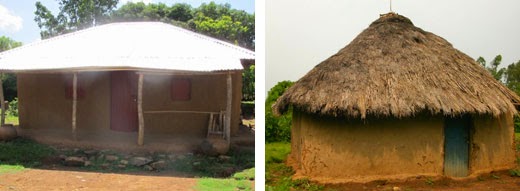Along with Paul and Chris, I spent last week in Rarieda Province Kenya, where I received a lesson in development from the poor themselves.
Before the trip, we knew from our data that a meaningful fraction of our recipients (endline results coming soon) spend a portion of their cash on housing improvements, and that the most common purchase in this category has been metal roofing (typically to replace thatch). To me, a new roof seemed like curious purchase. After all, I’m not aware of any non-profit dedicated to providing metal roofing. Like many, I wondered why this was such a popular choice. What was the logic behind this decision? Was this transformative, or just a form of conspicuous consumption? So I asked, and learned. This is what I found out…
- Increased “household income”: Thatch roofs not only leak regularly, but can collapse several times a year. A tin roof, which lasts 10–15 years, can save a household $100–$150 per year that would have been spent on the labor and materials for re-thatching the roof. For context, our average recipient lives on a budget of about 65 cents per day.
- Cleaner drinking water: Recipients who buy metal roofing usually add a gutter, which allows them to collect rainwater during the rainy season. As rainwater is often cleaner than local water sources, this may reduce incidence of waterborne diseases like typhoid fever and cholera.
- More time for work (or rest): Collecting water from the roof also saves recipients from walking to fetch water — often from several miles away, which gives household members more time to work or rest. (This is especially true for women, who are typically tasked with carrying water.)
- Fewer mosquitos (and malaria?): Thatch roofs leak and collect moisture, which makes them a favorite hiding place for mosquitoes. In addition to the comfort of having fewer bugs in their homes, evidence (broken link changed to archive.org link on 07/24/2019) suggests that people living under metal roofs may also experience lower rates of malaria.
In short, in Kenya, a metal roof is much more than a luxury item or a status symbol. It can be a solution to multiple problems, most of which we in the developed world will never experience ourselves. I was thoroughly impressed by the practical benefits of metal roofing, but nothing made a deeper impression on me than seeing the pride, dignity, and security that recipients felt in their safer, more comfortable homes. One cash transfer recipient’s wife had left him the last time his roof collapsed; when he purchased a new roof, they were reunited. When asked how the cash transfer and home improvements had affected his life, he replied, “I feel human again.”
Of course, a metal roof is not the solution to every poor person’s problems. What works in one village may not work in another. That is why cash transfers are so effective. By giving money directly to the poor, we give them the freedom to assess and address their own unique challenges, and we respect them enough to trust that they have more expertise in living their own lives than we do.
